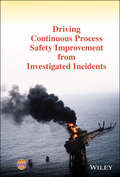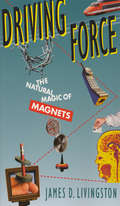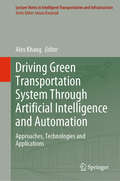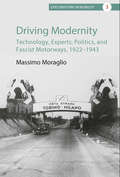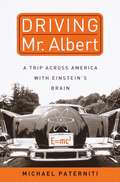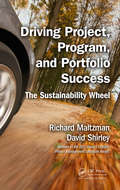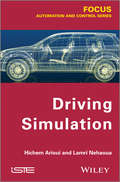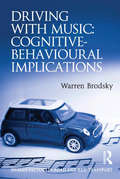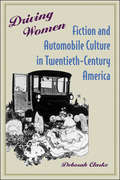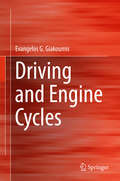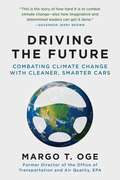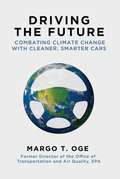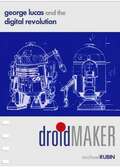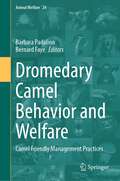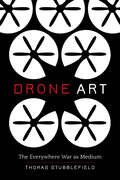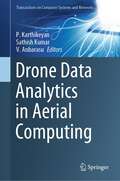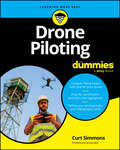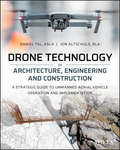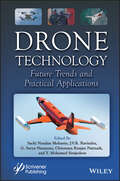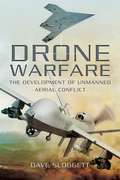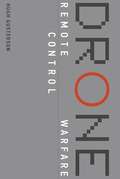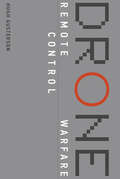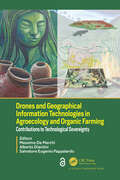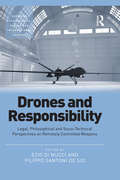- Table View
- List View
Driving Continuous Process Safety Improvement From Investigated Incidents
by CCPS (Center for Chemical Process Safety)New perspectives on how to share the lessons learned from publicly investigated process safety incidents Driving Continuous Process Safety Improvement from Investigated Incidents offers a novel view on how to successfully communicate process safety incident lessons. This book comes from the Center for Chemical Process Safety (CCPS), providing learning models and sharing techniques. This important book: Offers guidelines for improving process safety performance by applying the lessons learned from publicly available incident investigations Presents the background for and recommends a continuous improvement learning model Provides scenario examples for using the model’s techniques and how to internalize the learnings Written for safety professionals and process safety consultants, Driving Continuous Process Safety Improvement from Investigated Incidents is a hands-on guide for adopting a model for successfully communicating the learnings from process safety incident investigations.
Driving Force: The Natural Magic of Magnets
by James D. LivingstonDriving Force unfolds the long and colorful history of magnets: how they guided (or misguided) Columbus; mesmerized eighteenth-century Paris but failed to fool Benjamin Franklin; lifted AC power over its rival, DC, despite all the animals, one human among them, executed along the way; led Einstein to the theory of relativity; helped defeat Hitler’s U-boats; inspired writers from Plato to Dave Barry. In a way that will delight and instruct even the nonmathematical among us, James Livingston shows us how scientists today are creating magnets and superconductors that can levitate high-speed trains, produce images of our internal organs, steer high-energy particles in giant accelerators, and—last but not least—heat our morning coffee. From the “new” science of materials to everyday technology, Driving Force makes the workings of magnets a matter of practical wonder. The book will inform and entertain technical and nontechnical readers alike and will give them a clearer sense of the force behind so much of the working world.
Driving Green Transportation System Through Artificial Intelligence and Automation: Approaches, Technologies and Applications (Lecture Notes in Intelligent Transportation and Infrastructure)
by Alex KhangThis book is designed to help transportation professionals and construction experts to develop and implement successful smart systems, leveraging the current trends, equipment, and advanced technologies to drive the green transportation system development. Artificial intelligence (AI) is a new direction that has opened a revolution in technology and smart applications, and it is also the basis for creating a green environment in the net-zero era. Therefore, machines, devices, self-driving car, and robots controlled by artificial intelligence-based systems are now the model of a smart transportation ecosystem for which all these technologies are referred to as "green" industries. In past years, the idea of making a green environment has been existing and moving on the society 5.0 being as a country strategy, and today, AI technology continues its development on this prototype. Nowadays, AI has begun actions to resemble a person in a real sense, and the idea of human-liked robotics put forward by scientists has started to be realized and will probably complete its development as living machines in the near future. AI has many subsystems and application in various industries, some of which have automation more accurately and are more integrated in modern industries. This book also targets a mixed audience of specialists, analysts, engineers, scholars, researchers, academics, professionals, and students from different communities to share and contribute new ideas, methodologies, technologies, approaches, models, frameworks, theories, and practices to resolve the challenging issues associated with the leveraging of AI and Industrial Internet of Things (IIoT) in green transportation ecosystem.
Driving Modernity: Technology, Experts, Politics, and Fascist Motorways, 1922-1943 (Explorations in Mobility #3)
by Massimo MoraglioOn March 26th, 1923, in a formal ceremony, construction of the Milan–Alpine Lakes autostrada officially began, the preliminary step toward what would become the first European motorway. That Benito Mussolini himself participated in the festivities indicates just how important the project was to Italian Fascism. Driving Modernity recounts the twisting fortunes of the autostrada, which-alongside railways, aviation, and other forms of mobility-Italian authorities hoped would spread an ideology of technological nationalism. It explains how Italy ultimately failed to realize its mammoth infrastructural vision, addressing the political and social conditions that made a coherent plan of development impossible.
Driving Mr. Albert: a Trip Across America With Einstein's Brain
by Michael PaternitiDriving Mr. Albert chronicles the adventures of an unlikely threesome--a freelance writer, an elderly pathologist, and Albert Einstein's brain--on a cross-country expedition intended to set the story of this specimen-cum-relic straight once and for all.
Driving Project, Program, and Portfolio Success: The Sustainability Wheel
by David Shirley Richard MaltzmanBusinesses appear to have not only bought into integrating sustainability into their business plans, but have started profiting from it. This book helps project, program, and portfolio managers to integrate sustainability thinking into their projects. It introduces a new tool called the Sustainability WheelTM that tells you where you are and what you need to improve. With this tool, you can determine priorities for sustainability improvement, validate that present sustainability efforts are within your organization's mission/vision, and provide a mechanism to integrate sustainability into everyday operations.
Driving Simulation (Focus Ser.)
by Lamri Nehaoua Hichem AriouiPassive and active safety systems (ABS, ESP, safety belts, airbags, etc.) represent a major advance in terms of safety in motoring. They are increasingly developed and installed in cars and are beginning to appear in twowheelers. It is clear that these systems have provenefficient, although there is no information about their actual operation by current users. The authors of this book present a state of the art on safety systems and assistance to driving and their two-wheeled counterparts. The main components constituting a driving simulator are described, followed by a classification of robotic architectures. Then, a literature review on driving simulators and two-wheeled vehicles is presented. The aim of the book is to point out the differences of perspectives between motor vehicles and motorcycles to identify relevant indicators to help in choosing the mechanical architecture of the motorcycle simulator and appropriate controls. Contents 1. Driving Simulation.2. Architecture of Driving Simulators.3. Dynamics of Two-Wheeled Vehicles.4. Two-Wheeled Riding Simulator: From Design to Control.
Driving With Music: Cognitive-behavioural Implications (Human Factors in Road and Rail Transport)
by Warren BrodskyThis book, the first full-length text on the subject, explores the everyday use of music listening while driving a car. It presents the relationship between cars and music in an effort to understand how music behaviour in the car can either enhance driver safety or place the driver at increased risk of accidents. A great deal of work has been done to investigate and reduce driver distraction and inattention, but this book is the first to focus on in-cabin aural backgrounds of music as a contributing factor to human error and traffic violations. Driving With Music begins by outlining the automobile, its relationship to society, and the juxtaposition of music with the automobile as a complete package. It then highlights concepts from the fields of music perception and cognition, and, within this framework, looks at the functional use of background music in our everyday lives. Driver music behaviours - both adaptive and maladaptive - are explored, with the focus on contradictions and ill-effects of in-car music listening. To conclude, implications, applications and countermeasures are suggested.
Driving Women: Fiction and Automobile Culture in Twentieth-Century America
by Deborah ClarkeOver the years, cars have helped to define the experiences and self-perceptions of women in complex and sometimes unexpected ways. When women take the wheel, family structure and public space are reconfigured and re-gendered, creating a context for a literary tradition in which the car has served as a substitute for, an escape from, and an extension of the home, as well as a surrogate mother, a financial safeguard, and a means of self-expression.Driving Women examines the intersection of American fiction—primarily but not exclusively by women—and automobile culture. Deborah Clarke argues that issues critical to twentieth-century American society—technology, mobility, domesticity, and agency—are repeatedly articulated through women's relationships with cars. Women writers took surprisingly intense interest in car culture and its import for modern life, as the car, replete with material and symbolic meaning, recast literal and literary female power in the automotive age. Clarke draws on a wide range of literary works, both canonical and popular, to document women's fascination with cars from many perspectives: historical, psychological, economic, ethnic. Authors discussed include Wharton, Stein, Faulkner, O’Connor, Morrison, Erdrich, Mason, Kingsolver, Lopez, Kadohata, Smiley, Senna, Viramontes, Allison, and Silko. By investigating how cars can function as female space, reflect female identity, and reshape female agency, this engaging study opens up new angles from which to approach fiction by and about women and traces new directions in the intersection of literature, technology, and gender.
Driving and Engine Cycles
by Evangelos G. GiakoumisThis book presents in detail the most important driving and engine cycles used for the certification and testing of new vehicles and engines around the world. It covers chassis and engine-dynamometer cycles for passenger cars, light-duty vans, heavy-duty engines, non-road engines and motorcycles, offering detailed historical information and critical review. The book also provides detailed examples from SI and diesel engines and vehicles operating during various cycles, with a focus on how the engine behaves during transients and how this is reflected in emitted pollutants, CO2 and after-treatment systems operation. It describes the measurement methods for the testing of new vehicles and essential information on the procedure for creating a driving cycle. Lastly, it presents detailed technical specifications on the most important chassis-dynamometer cycles around the world, together with a direct comparison of those cycles.
Driving the Future: Combating Climate Change with Cleaner, Smarter Cars
by Fred Krupp Margo T OgeNow in paperback, with a new foreword by Fred Krupp, an expert's illuminating preview of the cleaner, lighter, smarter cars of the future.In Driving the Future, Margo T. Oge portrays a future where clean, intelligent vehicles with lighter frames and alternative power trains will produce zero emissions and run at 100+ mpg. With electronic architectures more like those of airplanes, cars will be smarter and safer, will park themselves, and will network with other vehicles on the road to drive themselves. As the director of the EPA’s Office of Transportation and Air Quality, Oge was the chief architect behind the Obama administration’s landmark 2012 deal with automakers in the US market to double the fuel efficiency of their fleets and to cut greenhouse gas emissions in half by 2025. This was America’s first formal climate action using regulation to reduce emissions through innovation in car design.Offering an insider account of the partnership between federal agencies, California, environmental groups, and car manufacturers that led to the historic deal, Margo discusses the science of climate change, the politics of addressing it, and the lessons learned for policy makers. She also takes the reader through the convergence of macro trends that will drive this innovation over the next forty years and be every bit as transformative as those wrought by Karl Benz and Henry Ford. Driving the Future is for anyone who wants to know what car they’ll be driving in ten, twenty, or thirty years-and for everyone concerned about air quality and climate change now.
Driving the Future: Combating Climate Change with Cleaner, Smarter Cars
by Margo T. OgeA distinguished expert offers a dazzling preview of the cars of the future, while exploring the science and politics behind climate change. As the director of the EPA’s Office of Transportation and Air Quality, engineer Margo Oge was the chief architect behind the Obama administration’s landmark 2012 deal with automakers in the US market to double the fuel efficiency of their fleets to 54. 5 mpg and cut greenhouse gas emissions in half by 2025. This was America’s first formal climate action using regulation to reduce emissions through innovation in car design. Tom Friedman praised the new rules as the "Big Deal” that redeemed the administration’s previous inaction. In Driving the Future, Oge portrays a future where clean, intelligent vehicles with lighter frames and alternative power trains will produce zero emissions and run at 100+ mpg. With electronic architectures more like that of airplanes, cars will be smarter and safer, will park themselves, and will network with other vehicles on the road to drive themselves. Offering an insider account of the partnership between Federal agencies, California, environmental groups, and car manufacturers that led to the historic deal, she discusses the science of climate change, the politics of addressing it, and the lessons learned for policymakers. She also takes the reader through the convergence of macro trends that will drive this innovation over the next forty years and be every bit as transformative as those wrought by Karl Benz and Henry Ford.
Droidmaker: George Lucas and the Digital Revolution
by Michael RubinThe inside story of George Lucas, his intensely private company, and their work to revolutionize filmmaking. In the process, they made computer history. Discover the birth of Pixar, digital video editing, videogame avitars, THX sound, and a host of other icons of the media age. Lucas played a central role in the universe of entertainment technologies we see everyday.
Dromedary Camel Behavior and Welfare: Camel Friendly Management Practices (Animal Welfare #24)
by Bernard Faye Barbara PadalinoThis volume gives a comprehensive review on dromedary camel handling and management by respecting its welfare, which is a global first. Beyond that, it provides a new welfare assessment tool.Expert authors lay the groundwork for understanding the animals by covering domestication, camels´ behavioral repertoire and needs, as well as dromedary camel genetics and coping with production systems. Then, the reader is equipped with the latest expertise on good management practices in camel farms, including transport, feeding, housing from racing to dairy systems, and health and hygiene. Moreover, the impact of innovative reproduction techniques and, finally, slaughter are taken into account.Camels, long confined to desert areas and kept extensively, have recently faced changes in husbandry systems and their environment. Intensification and specialization for milk, meat or sport purpose, as well as new geographic conditions have had significant impact on camel welfare.This book is a must-read for all camel industry members, breeders, veterinarians, and researchers, who want to practice camel breeding and management while safeguarding the behavioral needs and welfare of these amazing animals.
Drone Art: The Everywhere War as Medium
by Thomas StubblefieldWhat happens when a drone enters a gallery or appears on screen? What thresholds are crossed as this weapon of war occupies everyday visual culture? These questions have appeared with increasing regularity since the advent of the War on Terror, when drones began migrating into civilian platforms of film, photography, installation, sculpture, performance art, and theater. In this groundbreaking study, Thomas Stubblefield attempts not only to define the emerging genre of "drone art" but to outline its primary features, identify its historical lineages, and assess its political aspirations. Richly detailed and politically salient, this book is the first comprehensive analysis of the intersections between drones, art, technology, and power.
Drone Data Analytics in Aerial Computing (Transactions on Computer Systems and Networks)
by P. Karthikeyan Sathish Kumar V. AnbarasuThis book discusses the latest research, theoretical, and experimental research innovations in drone data analytics in aerial computing. Drone data analytics guarantees that the right people have the correct data at their fingertips whenever they need it. The contents also discuss the challenges faced with drone data analytics, such as due to the high mobility of drones, aerial computing is significantly different from terrestrial computing. It also includes case studies from leading drone vendors. The book also focuses on the comparison of data management and security mechanisms in drone data analytics. This book is useful to those working in agriculture, mining, waste management, and defenses department.
Drone Piloting For Dummies
by Curt SimmonsThe know-how you need to become a pro drone pilot and market your skill Licensed and skilled drone pilots are in huge demand. Drone Piloting For Dummies teaches you how to make a career out of it. From real estate to construction to inspection to mapping to delivery, the need for drone photography and videography is everywhere. This book outlines the basics of selecting and operating a drone, shows you how to get licensed, and explains all the regulations you need to know. You'll also learn to read charts and capture high-quality photos and videos. Plus, this guide walks you through the process of turning this skill into a full-time career or profitable side hustle. Written by a licensed drone pilot and entrepreneur, Drone Piloting For Dummies helps you take off on your new adventure! Grasp flying basics and care for your drone Prep for certification and learn the regulations Refine your photography and videography skills Market your skills and discover cool career opportunities This book is for anyone who wants to become a drone pilot or increase their piloting skills for job readiness and performance.
Drone Technology in Architecture, Engineering and Construction: A Strategic Guide to Unmanned Aerial Vehicle Operation and Implementation
by Daniel Tal John AltschuldA start-to-finish roadmap on incorporating drone technology into your AEC firm workflow Drone Technology in Architecture, Engineering and Construction: A Strategic Guide to Unmanned Aerial Vehicle Operation and Implementation is the only process-driven, step-by-step handbook to implement drone technology in AEC workflows. It provides a comprehensive and practical roadmap for architecture, engineering, and construction firms to incorporate drones into their design and construction processes. The book offers extensive information on drone data processing, and includes guidance on how to acquire, manipulate and use the various data types produced from drone flights. The creation of three-dimensional data and visualizations are covered in-depth. Drone Technology reviews how to select and fly drones based on data needs and initial costs, and how to collect and maintain required flight logs, licenses, and permits. Drone Technology uses several real-world project examples that demonstrate and explain how drones can be used to collect: · Full-color orthorectified imagery · Accurate 3D point cloud and mesh models · Topographic contours · Digital Elevation Models (DEMs) The project examples also describe how these datasets can be integrated with 3D models of proposed conditions, photos, and other project datasets. Drone Technology in Architecture, Engineering and Construction is an essential guide for a wide variety of professionals, from civil engineers to landscape architects. It provides information on professional use of drones for those just considering the technology, to those already flying drones professionally. It is an invaluable guide for anyone working in the design or construction of buildings and landscapes.
Drone Technology: Future Trends and Practical Applications
by Sachi Nandan Mohanty G. Surya Narayana Chinmaya Ranjan Pattnaik Y. Mohamed Sirajudeen J.V.R. RavindraDRONE TECHNOLOGY This book provides a holistic and valuable insight into the revolutionary world of unmanned aerial vehicles (UAV). The book elucidates the revolutionary and riveting research in the ultramodern domain of drone technologies, drone-enabled IoT applications, and artificial intelligence-based smart surveillance. The book explains the most recent developments in the field, challenges, and future scope of drone technologies. Beyond that, it discusses the importance of a wide range of design applications, drone/UAV development, and drone-enabled smart healthcare systems for smart cities. It describes pioneering work on mitigating cyber security threats by employing intelligent machine learning models in the designing of IoT-aided drones. The book also has a fascinating chapter on application intrusion detection by drones using recurrent neural networks. Other chapters address interdisciplinary fields like artificial intelligence, deep learning, the role of drones in healthcare in smart cities, and the importance of drone technology in agriculture. Audience The book will be read and consulted by a range of industry engineers involved with introducing drone technology to their daily operations.
Drone Warfare: The Development of Unmanned Aerial Conflict
by Dave SloggettAn unmanned aerial vehicle, commonly known as a drone, is an aircraft without a human pilot on board. Its flight is either controlled autonomously by computers in the vehicle, or under the remote control of a navigator or pilot on the ground or in another vehicle. Drone Warfare is one of the first books to examine the development and use of such aerial drones. Drones have been much maligned in the media and popular culture and there has been much controversy over their deployment. This book reveals the history of unmanned aircraft, their recent development, and why they have emerged onto the scene, setting the record straight about drones and their use. Drone Warfare answers questions such as: Why did the United States invest so highly drone technology? When did all that start? What barriers had to be overcome? What was there before drones arrived? What roles did drones play in Iraq and Afghanistan? Were they successful? What new developments emerged during operations? Did they save lives? How many have been shot down and where? Will all air forces be drone based in the future? What other applications may arise in the civilian market? In a timely publication, Drone Warfare sets the record straight on unmanned aerial vehicles and explores technology and usage around the globe. Skyhorse Publishing, as well as our Arcade imprint, are proud to publish a broad range of books for readers interested in history--books about World War II, the Third Reich, Hitler and his henchmen, the JFK assassination, conspiracies, the American Civil War, the American Revolution, gladiators, Vikings, ancient Rome, medieval times, the old West, and much more. While not every title we publish becomes a New York Times bestseller or a national bestseller, we are committed to books on subjects that are sometimes overlooked and to authors whose work might not otherwise find a home.
Drone Wars
by Peter L. Bergen Daniel RothenbergDrones are the iconic military technology of many of today's most pressing conflicts. Drones have captured the public imagination, partly because they project lethal force in a manner that challenges accepted norms and moral understandings. Drone Wars presents a series of essays by legal scholars, journalists, government officials, military analysts, social scientists, and foreign policy experts. It addresses drones' impact on the ground, how their use adheres to and challenges the laws of war, their relationship to complex policy challenges, and the ways they help us understand the future of war. The book is a diverse and comprehensive interdisciplinary perspective on drones that covers important debates on targeted killing and civilian casualties, presents key data on drone deployment, and offers new ideas on their historical development, significance, and impact on law and policy.
Drone: Remote Control Warfare
by Hugh GustersonDrones are changing the conduct of war. Deployed at presidential discretion, they can be used in regular war zones or to kill people in such countries as Yemen and Somalia, where the United States is not officially at war. Advocates say that drones are more precise than conventional bombers, allowing warfare with minimal civilian deaths while keeping American pilots out of harm's way. Critics say that drones are cowardly and that they often kill innocent civilians while terrorizing entire villages on the ground. In this book, Hugh Gusterson explores the significance of drone warfare from multiple perspectives, drawing on accounts by drone operators, victims of drone attacks, anti-drone activists, human rights activists, international lawyers, journalists, military thinkers, and academic experts. Gusterson examines the way drone warfare has created commuter warriors and redefined the space of the battlefield. He looks at the paradoxical mix of closeness and distance involved in remote killing: is it easier than killing someone on the physical battlefield if you have to watch onscreen? He suggests a new way of understanding the debate over civilian casualties of drone attacks. He maps "ethical slippage" over time in the Obama administration's targeting practices. And he contrasts Obama administration officials' legal justification of drone attacks with arguments by international lawyers and NGOs.
Drone: Remote Control Warfare
by Hugh GustersonDrone warfare described from the perspectives of drone operators, victims of drone attacks, anti-drone activists, international law, military thinkers, and others. Drones are changing the conduct of war. Deployed at presidential discretion, they can be used in regular war zones or to kill people in such countries as Yemen and Somalia, where the United States is not officially at war. Advocates say that drones are more precise than conventional bombers, allowing warfare with minimal civilian deaths while keeping American pilots out of harm's way. Critics say that drones are cowardly and that they often kill innocent civilians while terrorizing entire villages on the ground. In this book, Hugh Gusterson explores the significance of drone warfare from multiple perspectives, drawing on accounts by drone operators, victims of drone attacks, anti-drone activists, human rights activists, international lawyers, journalists, military thinkers, and academic experts.Gusterson examines the way drone warfare has created commuter warriors and redefined the space of the battlefield. He looks at the paradoxical mix of closeness and distance involved in remote killing: is it easier than killing someone on the physical battlefield if you have to watch onscreen? He suggests a new way of understanding the debate over civilian casualties of drone attacks. He maps “ethical slippage” over time in the Obama administration's targeting practices. And he contrasts Obama administration officials' legal justification of drone attacks with arguments by international lawyers and NGOs.
Drones and Geographical Information Technologies in Agroecology and Organic Farming: Contributions to Technological Sovereignty
by Massimo De MarchiAlthough organic farming and agroecology are normally not associated with the use of new technologies, it’s rapid growth, new technologies are being adopted to mitigate environmental impacts of intensive production implemented with external material and energy inputs. GPS, satellite images, GIS, drones, help conventional farming in precision supply of water, pesticides, fertilizers. Prescription maps define the right place and moment for interventions of machinery fleets. Yield goal remains the key objective, integrating a more efficient use or resources toward an economic-environmental sustainability. Technological smart farming allows extractive agriculture entering the sustainability era. Societies that practice agroecology through the development of human-environmental co-evolutionary systems represent a solid model of sustainability. These systems are characterized by high-quality agroecosystems and landscapes, social inclusion, and viable economies. This book explores the challenges posed by the new geographic information technologies in agroecology and organic farming. It discusses the differences among technology-laden conventional farming systems and the role of technologies in strengthening the potential of agroecology. The first part reviews the new tools offered by geographic information technologies to farmers and people. The second part provides case studies of most promising application of technologies in organic farming and agroecology: the diffusion of hyperspectral imagery, the role of positioning systems, the integration of drones with satellite imagery. The third part of the book, explores the role of agroecology using a multiscale approach from the farm to the landscape level. This section explores the potential of Geodesign in promoting alliances between farmers and people, and strengthening food networks, whether through proximity urban farming or asserting land rights in remote areas in the spirit of agroecological transition. The Open Access version of this book, available at www.taylorfrancis.com, has been made available under a Creative Commons 4.0 license.
Drones and Responsibility: Legal, Philosophical and Socio-Technical Perspectives on Remotely Controlled Weapons (Emerging Technologies, Ethics and International Affairs)
by Ezio Di Nucci Filippo Santoni SioHow does the use of military drones affect the legal, political, and moral responsibility of different actors involved in their deployment and design? This volume offers a fresh contribution to the ethics of drone warfare by providing, for the first time, a systematic interdisciplinary discussion of different responsibility issues raised by military drones. The book discusses four main sets of questions: First, from a legal point of view, we analyse the ways in which the use of drones makes the attribution of criminal responsibility to individuals for war crimes more complicated and what adjustments may be required in international criminal law and in military practices to avoid ’responsibility gaps’ in warfare. From a moral and political perspective, the volume looks at the conditions under which the use of military drones by states is impermissible, permissible, or even obligatory and what the responsibilities of a state in the use of drones towards both its citizens and potential targets are. From a socio-technical perspective, what kind of new human machine interaction might (and should) drones bring and which new kinds of shared agency and responsibility? Finally, we ask how the use of drones changes our conception of agency and responsibility. The book will be of interest to scholars and students in (military) ethics and to those in law, politics and the military involved in the design, deployment and evaluation of military drones.
